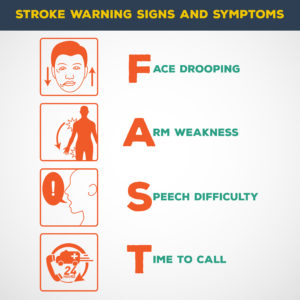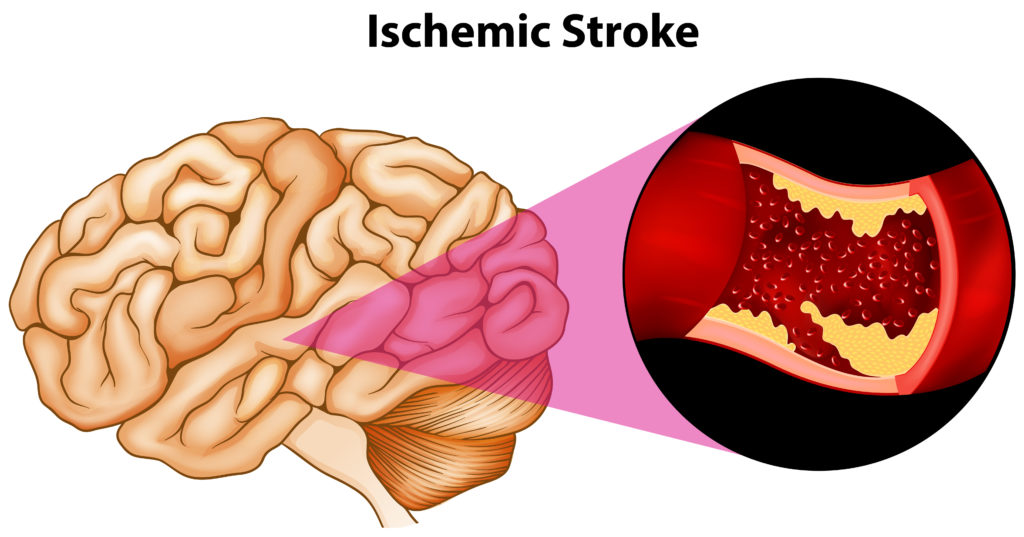
An estimated 150,000 people have a stroke in the UK each year, and over 10,000 of these people are under retirement age. Stroke has greater disability impact than any other chronic disease, and over 300,000 people are living with moderate to severe disabilities as a result of a stroke. Strokes can kill, and there are over 67,000 deaths due to stroke each year in the UK. Strokes are the third most common cause of death in England and Wales after heart disease and cancer. Stroke accounts for 9% of all deaths in men and 13% of all deaths in women.
Types of Stroke
There are two main types of stroke: Ischemic and haemorrhagic. The ischemic stroke happens when a clot blocks an artery that carries blood to the brain. It may be caused by a cerebral thrombosis, when a blood clot forms in the main artery to the brain. It may be a cerebral embolism. This is when a blockage caused by a blood clot, air bubble or fat globule forms in a blood vessel somewhere else in the body. It is then carried in the bloodstream to the brain. It may also be caused by a blockage in the tiny blood vessels deep within the brain.
The haemorrhagic stroke is a bleed when a blood vessel bursts causing bleeding (a haemorrhage) in the brain. It may be caused when the blood vessel bursts within the brain or when the blood vessel on the surface of the brain bleeds into the area between the brain and the skull. Again, this will starve at least part of the brain of oxygen.
Transient Ischemic Attack
Sometimes blockages in the blood supply to the brain are temporary. This means and a person will have symptoms of a stroke, but only for a short space in time. This is called a transient ischemic attack, or TIA. It is also known as a mini-stroke. Some people have just one TIA. Others have repeated TIAs over their life. A TIA is a sign that part of the brain is not getting enough blood and there is a risk of more serious strokes in future. As with major strokes, you must seek emergency medical treatment immediately. A stroke can happen with no obvious cause to people of any age, but there are factors known to increase the likelihood of it happening. Some of these factors are things that can’t be changed. Other risks may be reduced by lifestyle changes or medication.
The Brain
The brain is split down the middle into the left and right hemispheres. Each hemisphere controls one side of the body, however it is not as simple as that. The nerves for each hemisphere swap sides as they pass through the neck. Therefore the left hemisphere controls the left side of the face, but the right side of the torso and rest of body, and vice versa for the right hemisphere.
Signs and Symptoms
- Sudden headaches
- Confusion
- Numbness
- Paralysis down one side of the body
- Incontinence
- Not being able to coordinate the body
- Sudden blurred vision
- Unsteadiness
- Uncoordinated eyelids
A good mnemonic to use is FAST.
- Face. Has their face fallen down on one side? Can they smile or is their smile crooked?
- Arms. Can they raise both arms and keep them level?
- Speech. Is their speech slurred? Are they having trouble speaking?
- Time. You must call emergency services if you see any of these signs.
The first signs that someone has had a stroke are very sudden. The more quickly you identify that someone is having a stroke and the sooner they receive medical treatment, the more of the brain that can be saved, allowing the patient to have a much better chance of recovery.
Caring for a Stroke Patient
The care you give the patient is to help them onto the floor and place them in the recovery position on their affected side. Cover them with a blanket, calm them down and try to keep people away. They’ll be confused and scared, so try and avoid having onlookers. Losing bladder or bowel control is common, so protect their dignity at all times. Dealing with someone who is having a stroke can be very upsetting for the first-aider as well. Be aware of this and talk with a friend or medical professional if you need any help.
For more information on training courses, visit our “Courses” page which also includes our First Responder and First Person on Scene (FPOS) Courses.

